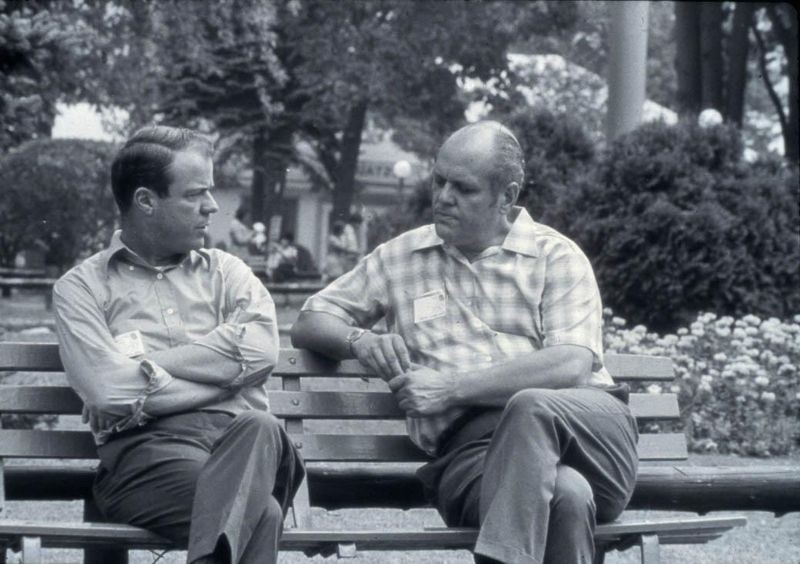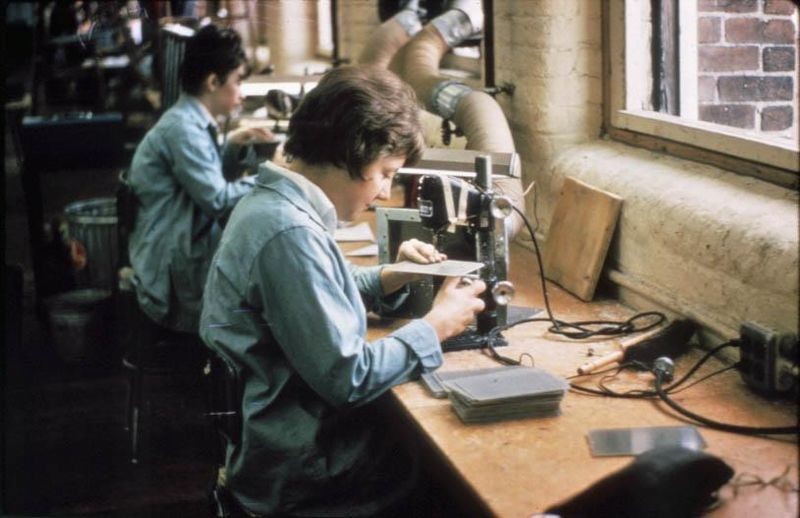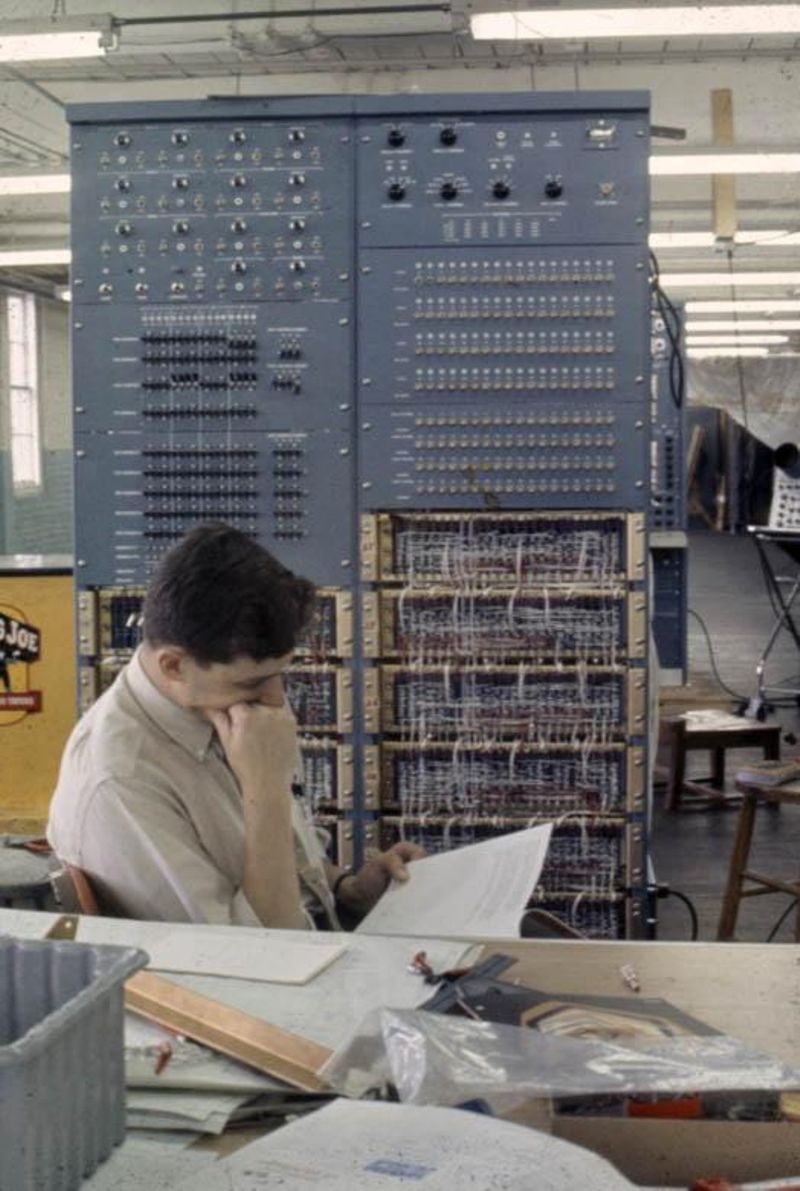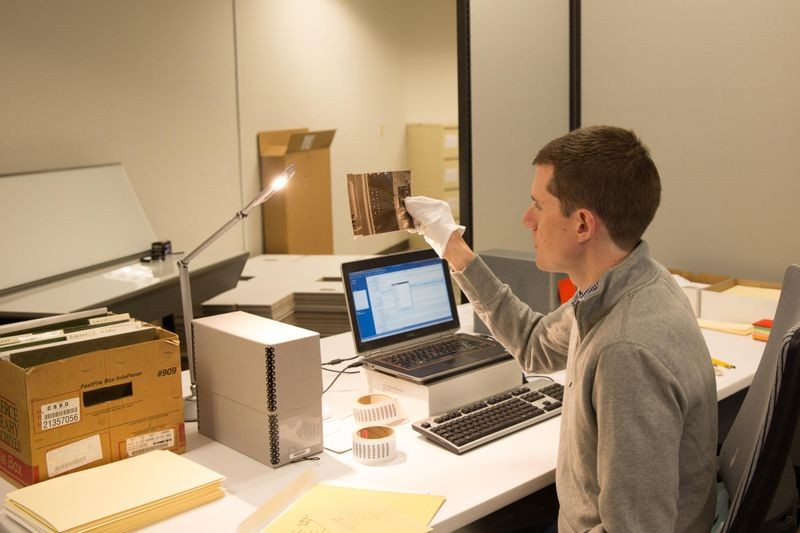

DEC co-founder and president Ken Olsen (right) in conversation with Win Hindle, assistant to the president, ca. 1965. Digital Equipment Corporation Records at the Computer History Museum, 102755967.
After 14 months and over 5,000 man hours the Digital Equipment Corporation’s (DEC) corporate archive is open for research!
Founded in 1957 by Ken Olsen and Harlan Anderson, DEC was one of the most successful computer companies of the 20th century, reaching nearly $14 billion in revenue and over 120,000 employees worldwide. Their seminal contribution—the minicomputer—was the revolutionary bridge between large-scale mainframes and personal computers. Blending a nontraditional business culture with a robust line of commercially successful computers, DEC made computing accessible to multiple new markets and changed the way society used technology. In addition to being smaller, faster, and cheaper than mainframes, the minicomputer was accessible to nonspecialized users.
Under Olsen’s guidance, DEC’s corporate structure lacked a rigid hierarchy or centralized decision maker. Instead, many teams of product line managers competed with other teams for the same company resources. There was a free flow of ideas and competition between departments and decisions were reached through sometimes contentious consensus of engineering, marketing, design, and review committees. More than any previous company, DEC’s decentralized structure encouraged creativity, innovation, freedom of expression, personal responsibility, and even fun. The somewhat confusing management structure empowered employees, and those who thrived in the environment nearly never wavered from their support of the company. DEC created and led the minicomputer industry, but ultimately failed to thrive in the personal computer era, in large part because of Olsen’s inability to see the coming dominance of the PC and open architectures, versus the proprietary systems DEC married to its machines.

Women made up a vital component of the DEC workforce, especially in the assembly and test operations of the computer production line. This photo from about 1965 shows two technicians drilling small holes into printed circuit boards, which would eventually comprise a computer. Digital Equipment Corporation Records at the Computer History Museum, 102755967.

As well as building computers, DEC built specialized test equipment for other computer manufacturers, like this automated memory tester from 1965 for checking the performance of magnetic core memory systems. Digital Equipment Corporation Records at the Computer History Museum, 102755967.
The Digital Equipment Corporation records are 1,239 linear feet of material in 1,343 boxes. The records represent the largest and most complete set of DEC records in existence, dating from 1947 through 2002, with the bulk from the company’s years of operation from 1957 through 1998, when they were bought by Compaq Computer. The collection is a comprehensive technical history of every major computing innovation at DEC, as well as its nontraditional business culture, which still serves as an industry model—nearly every contemporary company strives for a “culture of innovation.” The processing of the collection presents an extraordinary opportunity to study DEC’s product lines and business practices in depth as was never before possible. Very few companies as influential as DEC have as long a history, and the breadth and depth of this collection makes it unique in its comprehensiveness. The opportunities for study it presents are nearly limitless.
Included are the papers of executives Ken Olsen, Harlan Anderson, and Gordon Bell; various engineer’s papers; administrative records such as business and operational plans, committee meeting minutes, financial records and manufacturing plant records; large runs of internal newsletters such as Digital this Week and MGMT MEMO; the records of the Public Relations Department; DECUS records; promotional material, including sales guides, catalogs, price lists, brochures, and annual reports; and an abundance of technical newsletters and product manuals.
Of special significance is the inclusion of DEC’s photo library, which remains intact and contains over 17 thousand folders of prints, negatives, slides, and transparencies documenting the company’s products from the PDP-1 through the DEC station 325, as well as its personnel, facilities, and corporate culture. The Corporate Photo Library was one of the first departments at DEC, with its phone number listed in the company’s 1957 single-page directory.

Using a micrometer, an engineer checks the tolerances of a mass-produced component used in DEC computers, ca. 1965. DEC was one of the earliest companies to hire women engineers. Digital Equipment Corporation Records at the Computer History Museum, 102755967.
The opening of this collection has been a long time coming. In 2004 the Computer History Museum (CHM) received the collection from Hewlett-Packard, who had acquired Compaq, but did not have the resources to adequately address the collection until 2015 when CHM received a $274,500 grant to minimally process the collection as part of a larger project to process 26 of the Museum’s most valuable yet hidden collections. After a little over two years that project is nearing an end, and DEC is the crown jewel of that accomplishment. It is also a personal achievement for the Museum as its first iteration, the Digital Computer Museum, was established by Olsen and Bell in DEC’s Marlborough, MA lobby in 1979.
Thank you to the Andrew W. Mellon Foundation whose generous funding, administered through the Council on Library and Information Resources’ Cataloging Hidden Special Collections and Archives grant, made processing of the DEC collection possible. Thank you also to the project’s archivists Bo Doub and Kim Hayden, and Senior Curator Dag Spicer, as well as all of the volunteers who helped arrange and describe the collection, Sherman Baggett, Pat Bruder, Mike Gutman, Dick Johnson, Trudy Levy, Barry Sardis, Anna van Raaphorst, Ellen Wang, and Don Williamson. Without their commitment to the project this collection would remain inaccessible to historians, students, and fans of computing history.

Project Archivist Bo Doub studies a film negative from DEC’s Corporate Photo Library before cataloging.
The Computer History Museum is delighted to be able to preserve and provide access to this important collection as a fundamental piece in understanding the Information Age. Scholars now have the opportunity to study the most complete body of DEC primary source material in existence documenting every facet of DEC’s phenomenal business success and ultimate failure.
Read this story on Medium.